Info on the Tassie Circus Fest is pretty sparse. Details on the official website get wiped as soon as tickets are sold out. There are a few e-mails with info, but they don’t give a feel for the event at all.
In the interest of helping out people who haven’t yet been to the Australian National Circus Festival in Golconda, Tasmania, here are some packing tips and general information and observations based on my experience this year.
The basics first:
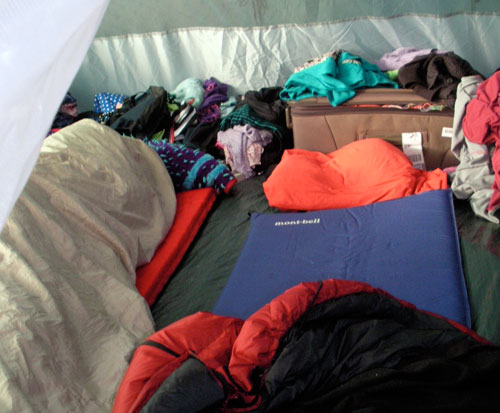
Inside our tent
Tasmanian summer is not like summer elsewhere. One day I woke to a 9C tent and that same afternoon sat in 38C sun watching a performance. Be prepared for anything.
Protection from cold. Bring warm things to sleep in and under. Raising yourself from the chilly ground is a good idea; a yoga mat + inflatable camping mat is better than either alone. A cot would be wicked. Bring gloves and warm socks, a warm hat, and maybe even a winter coat. A sweater/jumper is essential when the sun sets or the wind picks up.
Protection from sun. Sunscreen! You’re going to be outdoors 24/7. When it isn’t cold and raining in Tassie, it is sunny as hell. Slather up and consider a hat. If you are training, you’ll be sweating, so have a water bottle to keep from dehydration.
Protection from rain. At least bring an umbrella and carry it with you every day, along with your sunscreen and a jumper. Honestly, you will likely need all three in one day. If it rains too much, training sessions can be canceled, so bring something to occupy yourself on a wet day, just in case.
Protection from dark. A torch is handy. There are no lights in the camping areas. The moon and stars are bright enough to light the oval, but not helpful when you’re inside your tent.
Protection from pain. Training can be quite tough, so bring whatever you need to perform personal first aid. Painkillers, bandages, ointments for cuts, antiseptic lotions, arnica for bruises. Plus, there are aggressive biting ants, but crushed bracken root will ease that pain.
A carry bag. You will end up lugging your jumper, umbrella and sunscreen around with you, as well as your wallet and any training gear you need. A bag to put it all into is a smart idea.
Camping gear. A tent (or rent a camper van). Cooking gear as desired. You’ve been camping before so you know what you like in your camp site.
What to wear
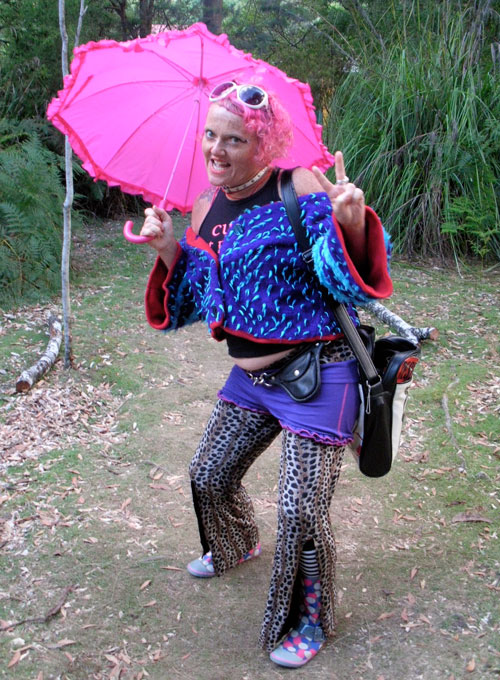
Jewelz has her own unique style!
For training, anything goes. Shorts, yoga gear, t-shirts or whatever you normally put on to train is great. Of course what that “whatever” is does vary by skill, so it’s good to have some cross-purpose pieces in case you want to branch out and try something new. This year, there were lots of black tops and stretchy pants of various lengths - practical and can be worn more than once.
Layers are smart for peeling on and off as the weather changes. Shoes you can slip on and off make getting into your tent easier. Jeans are great in the evening. An extra jumper is essential all day long. My lightweight fleece jacket was on my body at least 12 hours a day. Something that blocks the wind would be useful.
At night during the public festival, the dressing stakes go waaaay up. The Bedouin Club is posh. Fur wraps (smart and warm!), vintage dresses, hats, full makeup, glitter, sequins, jewelry, handbags, and heels are du rigeur for ladies and men. Whether you choose a dressy or a quirky style, you want to look great. During the public festival, there are second hand clothing stalls to help you find the right pieces to complete your ensemble. I do recommend something warm to cover your shoulders on the walk from your tent to the club. (And do your makeup before sunset - it’s challenging to make up well with a torch and a hand mirror in your tent!)
Other stuff to bring:
A notebook and pen. Take a few minutes to write down things you learned every day. There is so much to experience, you will be surprised when you review your notes at the end of the training. Good luck trying to describe those tricky physical moves but even a weird description may jog your body’s memory.
Business cards. To hand out to people you want to keep in touch with. Just in case they didn’t bring a notebook to write your name in.
A camera. Photos are a great way to capture memories and add to the documentation in your notebook. Snaps of stance, grip and those other hard-to-describe details can really help you take home the right information.
Ziplock bags. Useful for storing opened food packets, tidying your tent and keeping small things dry in the rain.
What not to bring
Video cameras. Still photography without flash is fine, but no videos. Stay in the moment and enjoy the magic. This can be frustrating when you want to capture something you are involved in, but suck it up and make your body do the remembering!
Cell phones. There is zero coverage, unless you are a lucky Telstra user who can find the magical square meter with one bar of reception. There is a booth under the pine tree with an old desk phone that takes prepaid cards (available at the Playground Cafe). There are sometimes long lines to use the phone. Don’t promise daily calls home.
Bathing suit. There are no swimming facilities. There is a beautiful pond next to Tony’s house, but it is for the platypus and duck. Look but don’t dive in.
Zip ties and gaff tape. Waste, waste, waste.
Alcohol. There is plenty in the cafe and bar. Please support the festival by buying it in the licensed venues. And don’t forget to put your empties in the recycling barrels.
Pets. Poochie stays at home. Cats and dogs don’t do circus training. If your act includes a trained monkey or dancing bear, check with Tony, I guess! Children of all ages are welcome.
About the facilities:
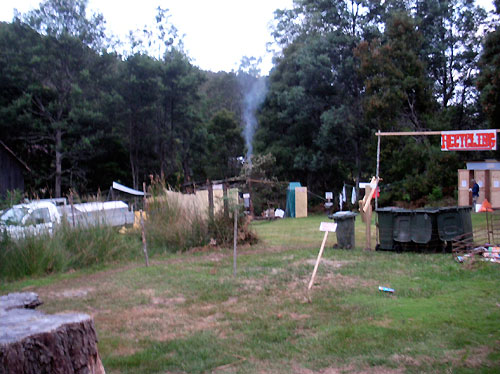
A peek at the showering, toilet and recycling area
It is a Zero Waste Site. Circus Fest is held on private property owned and loved by the man who runs the festival, Tony Rooke. He’s lived there 40 years and the place is amazing. Do your best to keep it pristine. Pick up your micro-rubbish - the bits of wrappers, bottle caps and feathers that blow away or slip out of your hand…
There is extensive recycling for your use. You will dump your food scraps into composting bins, recycle glass, tin cans, cardboard, and plastic bottles. Don’t forget to clean them out and crush them; don’t be gross. Any other garbage you generate, you must take away with you.
There are two sinks for washing dishes near to the compost bins. There is a basin for doing clothes and a convenient clothesline near the showers.
There are three rustic shower stalls that are usually not very hot. To heat the showers, build a fire and wait 15 minutes or until the boiler makes a distinctive rattling noise. When the water cools, add more wood to the fire and wait again. There’s one passive solar shower, too. There are also rather long lines for the showers at peak times, even with the 100 second shower water limit. Plan accordingly. Use organic, biodegradable soap and shampoo, please. Personally, I showered every other day and just wiped off the worst of the grime in between and dabbed on some tea tree oil. We were camping, everyone was sweaty and dirty and it didn’t seem to matter too much. But maybe I would have made more friends if I had showered more frequently.
Toilets are a fascinating system at Circus Fest. First, there are urinals for men and for women. The men’s is basically a tin-lined ditch behind a screen. Women have squat toilet style stalls - so learn to aim, ladies. The drop toilets with seats are for solid waste only, “no pee pee” Paper is provided. The stalls are cleaned every day and sprinkled with loads of lavender from a nearby farm. The odor is bearable and distinctive, though not pleasant.
It took a while to get my body learn to to stand in line, pee, stop, stand in another line, and then poo without peeing. But it was possible - 95% of the time, anyway. Many jokes and conversations revolved around the odd arrangement of the facilities, but we all seemed to manage with as much grace and good humour as possible.
About the workshops:
They are incredible. There is more to do than you can imagine. 60 workshops every day - some run as a course for the full five days, others are repeated daily, some riff on their topic depending on who attends. No matter what you decide to do, you’ll learn heaps. Your fellow trainees have lots to share, too, so be prepared to make firends and pick brains. There is a great feeling of camaraderie during training.
The one thing I really didn’t like about Circus Fest was the workshop sign-up process. There are two sign-up sessions and you are allowed to sign up for a certain few number of workshops for the whole week (eleven was the number, so about two workshops a day) with no repeats. After the official sign-up sessions are over and everyone has had their chance, the rosters are left open for anyone to fill in the gaps.
Ostensibly this is fair. But the mechanics of it are very awkward. There are long lines to get access to the 60 clipboards arrayed on tables, then it is an all-arms-and-pens crush to find the workshop you want and scribble your name. There is effectively nobody monitoring the number of workshops you sign up for, so anyone could cheat for more than their fair share. The geek in me thinks there would be a smoother computer-mediated solution, but that’s not really in keeping with the offline spirit of the festival. Maybe if there were more space to move, or assigned times based on your ticket purchase date or your seniority at the festival or…I don’t know. Something to reduce the stress of sign-ups would be good.
As it turns out, after the first couple of days, you get to know the instructors and they let you attend again whether you are registered or not (as long as there’s not a limited number of props or gear). So it’s all pretty chilled out in the end, but the signing up part was stressful.
Food and drink options:

The Playground Cafe
Mealtimes are a little tricky - training starts at 11 and runs straight through until 6, but there are yoga and warm up sessions that begin at 8 am and there is a cabaret stage every night during training. There are no breaks for lunch or other meals unless you make them for yourself by skipping a session.
You might want a lot of easily carried, high calorie snacks to munch in the minutes between workshops. Dried fruit and nuts, crackers, stuff like that.
Our camping crew ate breakfast together every morning and we cooked dinner most nights. It was economical and a pleasant way to unwind and share our training notes before going to the cabaret. We ate well. I think next time, we’ll take an esky to keep produce fresh a bit longer.
There are two restaurants plus a bar open during training. Restaurant meals are between 10 - 15 dollars and the menu is limited to your choice of the meal being served at Trevor’s or the one at the Playground Cafe. Dinner is different every night; breakfast is always the same big plate of traditional yum (vegetarian at Playground, with bacon and/or wallaby at Trevor’s). The food was consistently delicious. When the public come for the last three days, there are extra stalls and tents selling food.
Coffee is $3, soft drinks are available and various prices, and alcohol starts around $5. Be sure to try the homebrewed Horehound Mead. It’s wonderfully bitter.
Water! “Bring your own” said the FAQ this year and that sort of startled me. A week’s worth of water? That is a lot! You won’t have to bring it all, but bringing some of your own (in the form of large jugs from home or from the supermarket en route to the property) is not a bad idea because there are only two spring-fed taps providing drinking water for 200 trainees. There is also water available for sale at the Playground Cafe for $1/litre.
On the day off:
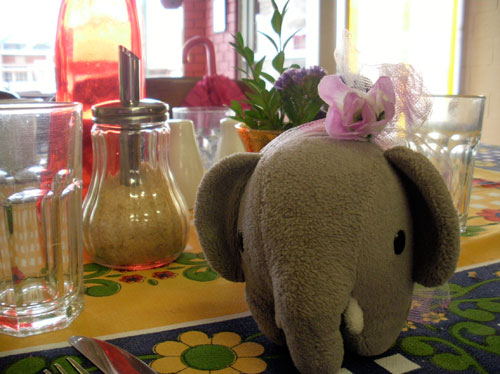
Zoupi liked the cafe in Scottsdale
The day off between the training and public festival is a good chance to restock and relax. We enjoyed a bit of shopping and lunch in Scottsdale, about 20 minutes drive from Lone Star. Alternately you can go to Lilydale, a similar village a bit further in the opposite direction from camp or all the way to the town of Launceston, about an hour’s drive away.
In Scottsdale there is a Coles and a Chickenfeed ($1 store), several op shops and some lovely cafes. We restocked with produce and bread, did laundry, and generally had a nice day in civilisation that included four walls and air conditioning. It was a treat to use a toilet that flushed and offered hand soap. But it was awesome to come home to camp at the end of the day. Camp is good!
We arrived back just as the public were starting to arrive. We expected a long line of cars and campers, but it wasn’t bad and we got to skip ahead through the side field to the entrance for trainees/crew/performers. The public and trainees camp in different sections of the property, so that security can be maintained for those of us with equipment and stuff.
Security:
Everyone is assigned a color-coded tag on a string on arrival. I tied mine around my neck and kept it on for the entire time - slept in it, showered in it, pretty much forgot it was there. Lovely necklace!
It’s not so critical to wear it during training but at the public festival, your tag will get you the trainee discount in the restaurants, gives you access to the Bedouin Club, and allows you to enter the camping area. so do your best not to lose it, though we were told it was the string color that really mattered - the tags do tend to fall off.
We had no problems with theft or vandalism, but I would not take your very precious valuables to camp with you. Just in case.
Shifting from training to festival mode:
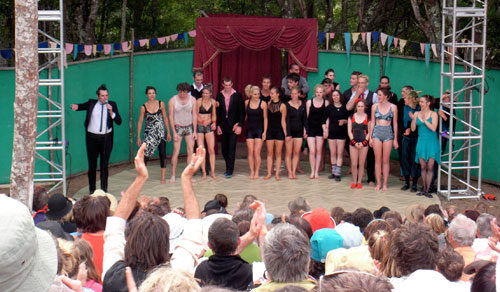
The Birdmann leads the crowd in a round of applause
They are both fabulous experiences. During training you are working hard, forge new friendships, play with your craft and get into the spirit of living outdoors. During the festival you can relax and enjoy the spectacle of dozens of shows, feast and shop at the new stalls, and party as hard as you like. The festival crowds are bigger so the atmosphere is different. Someone described it as being invaded, but for me, it was much more of a celebration. I loved both parts of the event equally.
